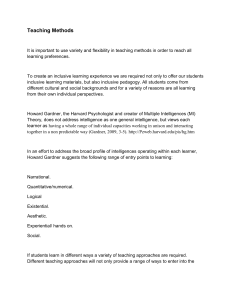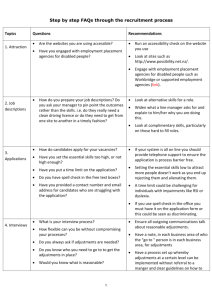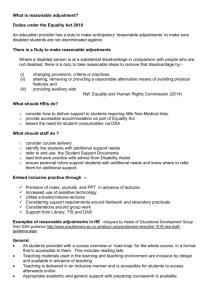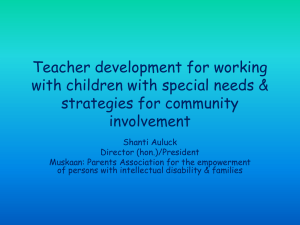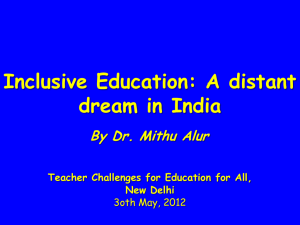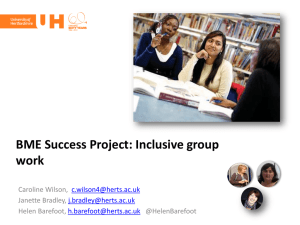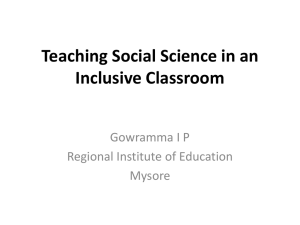Inclusive_Practice_in_Learning__Teaching_Powerpoint
advertisement
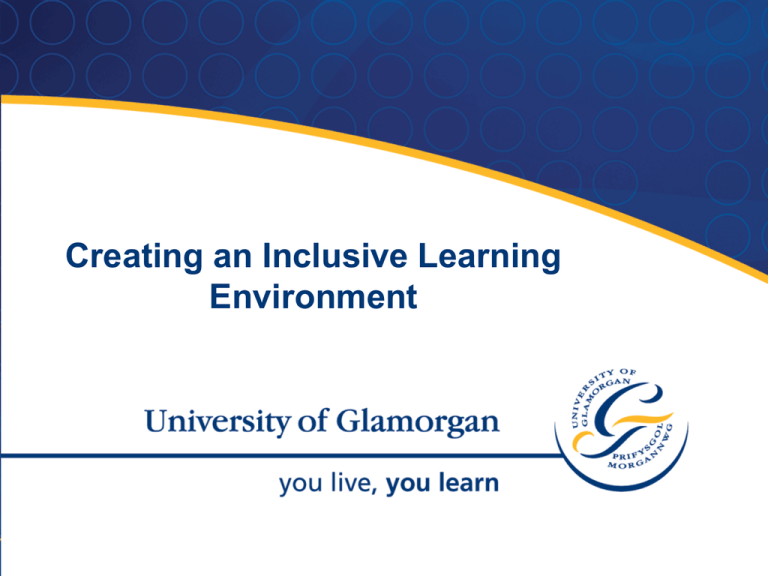
Creating an Inclusive Learning Environment 1 2 Structure of this seminar • What is inclusivity in learning & teaching? • Legislative duties. • Barriers to learning and how to overcome them. • Reasonable adjustments. • Importance of academic standards. Focus on disability: making courses more accessible to disabled students automatically makes them more accessible to all students. 3 What is Inclusivity? • Accessibility: aims to make learning, teaching and assessment accessible to disabled people. • Inclusivity: aims to make learning, teaching and assessment accessible to people from a wide range of different educational, cultural and socio-economic backgrounds. Inclusivity recognises that people are individuals, each with their own strengths and weaknesses. 4 What Inclusivity is NOT about • Lowering standards • More paperwork and hassle • “Political correctness” or getting into trouble for using the wrong words Inclusive practice in Learning & Teaching • …is about finding practical, common-sense solutions to remove barriers that prevent students from participating/achieving. • Benefits all students, not just disabled students or “awkward cases”. • Increases retention; improves degree attainment; enhances academic standards. • Inclusive practice is good practice. 5 As lecturers we have a duty under equality legislation not to discriminate (directly or indirectly) or disproportionately disadvantage students on the basis of: • • • • • • Race Religion & Belief Gender Disability Sexual Orientation Age 6 7 Disability Discrimination Act 2005 • Discrimination against disabled people is illegal. • There is a duty to make reasonable adjustments to disabled people generally, not just to particular individuals. • There is therefore an anticipatory aspect to this duty •This anticipatory duty is included in gender and race legislation 8 What is a disability? • The Disability Discrimination Act (DDA) defines a disabled person as someone who has a physical or mental impairment that has a substantial and longterm adverse effect on his or her ability to carry out normal day-to-day activities. • Examples: dyslexia; mental health conditions; epilepsy; diabetes; arthritis; cancer; HIV/Aids; visual, hearing or mobility impairments. So how do we make our courses inclusive? • Up to now, adjustments for individual students have been reactive • Inclusivity is a proactive approach: teaching staff are required under the DDA to anticipate the needs of their students “But how can I anticipate the needs of students I don’t (yet) have?” 9 10 To make our courses more inclusive, we need to remove barriers incidental to the course’s learning outcomes. Consider the demands of L&T activities on students’ capacities: • • • • • • Vision and hearing Speech and language skills Mobility and dexterity Concentration and stamina Cognition and working memory Social skills and awareness 11 For example, a traditional lecture (where the lecturer talks and writes on the board for an hour while the students take notes) disadvantages the following students: • Students with visual/hearing impairments. • Dyslexic students (lack of dexterity – writing notes while trying to concentrate on what’s said is a challenge for dyslexic students). • Students with concentration problems (e.g. ADHD). • Students with fatigue issues (MS, medication, or a long day at work if evening lecture). • Students who struggle with English. • Students who can’t attend the lecture (e.g. because of illness, disability, work, childcare responsibilities) 12 It is very straightforward to make the lecture described in the last slide more inclusive: • Provide lecture notes in advance on Blackboard or at the start of the class. • Build participation/discussion into the lecture: keeps students more engaged and more alert. • Allow students to record your lectures. • Make use of podcasting. • These simple strategies enhance students’ learning, remove barriers that prevent students from learning effectively or from attending, and increase retention and attainment. Tips for inclusive teaching: • Draw on multiple capacities • Offer multiple/flexible ways of participating • Provide structure at the start (map), and refer back to it periodically (signposts) • Provide instructions e.g. for group work in writing, in advance if possible, or be sure to read them out • Make social/classroom conventions explicit, e.g. how participants will indicate that they have a question • Provide mini-breaks/changes in activity type • Make use of BlackBoard / Podcasting • Make sure people don’t feel uncomfortable if they need to stand up or leave the room for a moment, or provide sufficient breaks for them to do so unobtrusively 13 Group Work 14 • Establish clear guidelines and “ground rules” (showing respect for each other’s views, not interrupting, how to ask questions etc). • Emphasise importance and advantages of working together with people from different backgrounds / different range of abilities. • Assign people into groups – if students form their own groups, some students (international/disabled) will be excluded. Group Work (cont.) 15 • Monitor groupwork to ensure everyone in the group is participating fully. • Provide clear instructions for group work tasks in writing, in advance if possible, or be sure to read them out. • Encourage students to reflect on how their behaviour can impact on the learning activities of others. • Consider running an equality and diversity group-based exercise – helps to break down barriers and is very beneficial to students who are confused about social conventions. 16 Reasonable Adjustments Under the DDA the University must take reasonable steps to ensure that disabled people are not placed at a disadvantage in comparison to someone who is not disabled. Factors to consider in assessing reasonableness: • maintenance of academic standards • health and safety requirements • practicality 17 Academic Standards “The academic standards reason should not be used spuriously. Where elements are not central or core to a course, they are unlikely to provide a reason to justify discrimination based on academic standards.” DDA Part IV Code of Practice, 4.27 It is therefore necessary to identify the central or core elements of any course. It is only academic staff who can make this judgement 18 “What am I trying to teach?” • If you can articulate what is essential and non-negotiable, you will find ways around barriers when it is possible to do so; and you will be able to say with confidence and with justification when it is not possible. • A clear statement of the limits to flexibility is an important part of making a course genuinely accessible. 19 Examples of reasonable adjustments A student with a mobility impairment can’t participate in a field trip to the summit of Cadair Idris. • Can the course’s learning outcomes only be achieved by scaling this mountain? • What are the alternatives? – Geological features in roadside cuttings, etc – Alternative fieldwork, e.g. OU’s fieldwork course for students with mobility and visual impairments • Do all the students on the field trip have to do the alternative option? – NO! 20 Examples of reasonable adjustments Dyslexic student • Provide support to develop strategies in the classroom or placement • Make lecture notes available in advance or on Blackboard • Coloured paper or tinted overlay/glasses • Mp3 recorder. • Spelling: give dispensation in exams if meaning can be discerned, i.e. not in cases where spelling is fundamental to meaning (hypothermia/hyperthermia, sulphide/sulphite/sulphate) 21 Examples of reasonable adjustments A student with young children can’t attend lectures earlier than 10am or later than 3pm. • Rescheduling of classes? Impractical therefore probably not reasonable. • Lecturer gives student catch-up tutorials? Impractical therefore possibly not reasonable. • Lecturer provides lecture notes. Reasonable. • Make podcasts of lectures available. Reasonable and may be best option. “How do I change my assessment to ensure it is accessible to disabled/dyslexic students?” Four available choices: 1. Change of assessment circumstances (e.g. Change of room) 2. Assessment modification (e.g. giving extra time or not marking down for spelling) 3. Alternative assessment (Oral or prepared essay rather than a written exam) 4. No change – as academic standards or learning outcomes would be compromised If 1, 2, or 3: - Does assessment still test learning outcomes? - Should all students be offered the changed assessment? 22 Summary: how to make your course inclusive • Anticipate the needs of your students. • Be flexible and adaptable. • Make reasonable adjustments to enable a student to participate fully in the course/assessments. – – – – Be creative. Ask the Inclusive Curriculum Officer for suggestions. Use common sense. Do not compromise academic standards. • Give all your students frequent opportunities to discuss their needs with you in private. • If you’re not sure how best to support a student, then ASK! Ask the student, ask Student Services, ask the Inclusive Curriculum Officer. • Respect confidentiality. 23 24 • Works with academic staff to make courses/modules more inclusive while maintaining academic standards. • Advises academic staff on how to make reasonable adjustments for particular students. • Aims to identify & disseminate good practice in L&T. • Conducts academic research into inclusivity/good practice in L&T.
